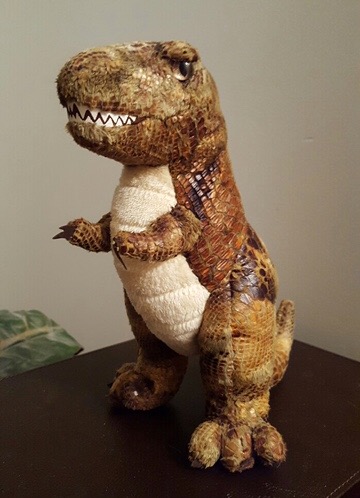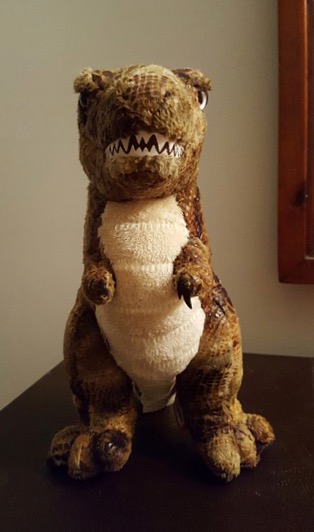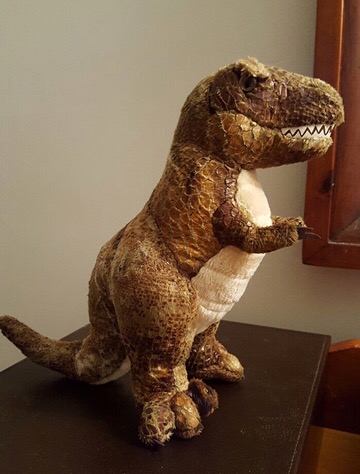Review and photos by Bryan Divers, edited by Suspsy
Few dinosaurs are as well known as the mighty Tyrannosaurus. It is also the only dinosaur commonly known by its binomial scientific name: Tyrannosaurus rex instead of just Tyrannosaurus. T. rex is my favourite dinosaur, and I love soft toys, so this one is a double favourite for me. I named my T. rex “Sue” after the one in the Field Museum. Recently, scientists have suggested that Tyrannosaurus had feathers, though I can’t personally imagine this. T. rex jaws are clearly crocodilian in their shape and teeth, and impressions have been found of their skin, showing it was indeed scaly and reptilian (Editor’s note: see my comment below).

Here is the Tyrannosaurus produced by Douglas Cuddle Toys. She is about 10 inches long from nose to tail, and about 4 inches wide. The fabric used in the construction of the toy is amazing, with its realistic reptilian scales. The stomach is stitched at intervals to give the feel of a somewhat wrinkled belly. The workmanship around the eyes and jaws is awesome. The ridges over the eyes are cleverly made and the jaws are stitched together with a printed fabric made to look like teeth in front, joining the two jaws together. She even has little thread nostrils if you look very closely! The eyes are alligator-like, with slitted pupils.

The pose of the dinosaur is admittedly a bit dated, but it would be extremely difficult to construct a plush T. rex in a horizontal position that would still stand up. Even her short little arms are accurate. A number of Tyrannosaurus soft toys depict them as having three fingers; effectively rendering it an Allosaurus. Not Sue. This beauty correctly show the two fingers and claws of a Tyrannosaurus.

If you need a Tyrannosaurus for travel, Sue is your gal. Her price is moderate for a toy of her quality and her small size makes her a perfect travel buddy. She is available on eBay, www.stuffedsafari.com, and Amazon.

Disclaimer: links to Ebay and Amazon on the DinoToyBlog are affiliate links, so we make a small commission if you use them. Thanks for supporting us!




This dinosaur toy has been redesigned; would anyone like a review of the mew one? The new one has a sound chip inside that roars when squeezed, amd a different belly material.
No way, I want you to do more reviews on the Animal Toy Blog instead!
Looks like a girlfriend for Barney.
Awww what a great peluche! It’s old fashioned.
Aww! I like how the head actually resembles the shape of a T. rex skull.
Very cute. I would love this.
Have to take issue with a couple of items in that first paragraph. One, aside from the fact that both tyrannosaurs and crocodilians could deliver crushing bites, there’s NOT a lot of anatomical similarities. T. rex is no more closely related to a crocodilian than a condor is. And two, the purported Wyrex skin samples are very tiny and come from the underside of the tail. According to Matt Martyniuk, Paul Sereno has the samples and has concluded that they do not show true scales and look bore like the skin of a plucked chicken. Such skin could have bore feathers in life.
So no, it is not correct to say that we know T. rex was scaly and reptilian in real life.
I apologise if the skin impressions did not show true scales; I was not aware of that update. And I only meant that a T. Rex’s jaws were crocodilian in the sense that they were long with triangular teeth and the eyes were crested and the nostrils were situated on the top of the head. Birds don’t have jaws made of flesh and bone; they have beaks. So I still don’t think T. Rex had feathers, but perhaps it didn’t necessarily have scales either.
T. rex teeth are distinctly different from crocodile teeth—they have serrated edges and a D-shaped cross section. As for the nostrils, it is now speculated that the actual openings were situated further down the snout, not on top.
Sorry. I guess maybe T. Rex isn’t so much like a crocodile after all. But I still think it looks more reptilian than avian. T. Rex teeth are similar in shape to those of Komodo dragons. The head shape is also similar.
Only superficially. Any paleontologist will happily inform you that T. rex is more closely related to an eagle or a chicken than a crocodile or a lizard.
Also, a great many feathered theropods, including tyrannosaurs, do not have beaks. The absence of a beak cannot mean the absence of feathers too.
I like this peluche, Is so tiny!
Killekor